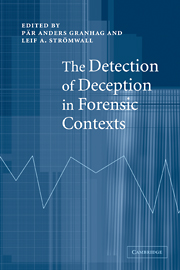Book contents
- Frontmatter
- Contents
- List of figures
- List of tables
- List of contributors
- Part 1 Introduction
- Part 2 Lie-detection techniques
- 2 Discerning lies from truths: behavioural cues to deception and the indirect pathway of intuition
- 3 Statement Validity Analysis and the ‘detection of the truth’
- 4 Reality monitoring and detection of deception
- 5 The psychophysiological detection of deception
- Part 3 Special issues facing a lie-catcher
- Part 4 Enhancing lie-detection accuracy
- Part 5 Conclusions
- Index
- References
4 - Reality monitoring and detection of deception
Published online by Cambridge University Press: 22 September 2009
- Frontmatter
- Contents
- List of figures
- List of tables
- List of contributors
- Part 1 Introduction
- Part 2 Lie-detection techniques
- 2 Discerning lies from truths: behavioural cues to deception and the indirect pathway of intuition
- 3 Statement Validity Analysis and the ‘detection of the truth’
- 4 Reality monitoring and detection of deception
- 5 The psychophysiological detection of deception
- Part 3 Special issues facing a lie-catcher
- Part 4 Enhancing lie-detection accuracy
- Part 5 Conclusions
- Index
- References
Summary
Research on eyewitness testimony has primarily focused on memory errors. In this chapter, the focus is not on eye-witness errors but on the application of Johnson and Raye's (1981) reality monitoring (RM) model to detection of deception. The central question is whether or not it is possible to discriminate truthful from deceptive statements on the basis of content aspects outlined by the RM theory. This approach is akin to Statement Validity Analysis, in particular the Criteria-Based Content Analysis (CBCA) component, which also has focused on qualitative differences between truthful and deceptive accounts (for reviews, see Ruby and Brigham, 1997; Sporer, 1983, 1997a, 1997b; Steller and Köhnken, 1989; Vrij, 2000, in press).
Reality monitoring approach
In a seminal paper, Johnson and Raye (1981) asked how people go about discriminating memories of externally derived (perceptual) experiences from memories of internally derived experiences. This process has been termed reality monitoring (RM). In a deception situation, a communicator constructs an event either from scratch or on the basis of similar experiences, thus reporting on a new current event, not a memory of a past event. According to RM theory, people rely on qualitative characteristics of memories to decide whether a memory is based on an actual experience or not. It is assumed that externally derived memories contain more references to sensory information (visual details, colours, sounds, odours, touch, taste), contextual information (about space and time), emotions and feelings, and semantic information.
- Type
- Chapter
- Information
- The Detection of Deception in Forensic Contexts , pp. 64 - 102Publisher: Cambridge University PressPrint publication year: 2004
References
- 93
- Cited by

